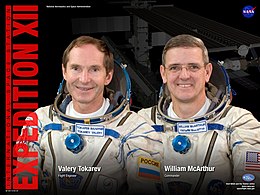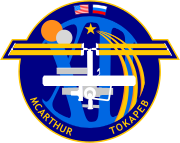Expedition 12
 Promotional poster | |
| Mission type | Long-duration expedition |
|---|---|
| Mission duration | 187 days, 14 hours, 1 minute (at ISS) 189 days, 19 hours, 53 minutes (launch to landing) |
| Orbits completed | 2,987 |
| Expedition | |
| Space station | International Space Station |
| Began | 3 October 2005, 05:27 UTC |
| Ended | 8 April 2006, 19:28 UTC |
| Arrived aboard | Soyuz TMA-7 |
| Departed aboard | Soyuz TMA-7 |
| Crew | |
| Crew size | 2 |
| Members | William S. McArthur Valeri I. Tokarev |
| EVAs | 2 |
| EVA duration | 11 hours, 5 minutes |
 Expedition 12 mission patch  William S. McArthur, Jr. (United States left), Valeri I. Tokarev (Russia right) | |
Expedition 12 (2005) was the 12th expedition to the International Space Station, launched from Kazakhstan using the Russian Soyuz TMA-7 spacecraft. The crew landed back in Kazakhstan on 8 April 2006 with the addition of the first Brazilian astronaut, Marcos Pontes.
American entrepreneur Gregory Olsen was launched in the Soyuz TMA-7 spacecraft and returned with Expedition 11 on Soyuz TMA-6 on 11 October 2005 thereby becoming the third space tourist.[1]
Crew
[edit]| Position | Astronaut | |
|---|---|---|
| Commander | Fourth and last spaceflight | |
| Flight Engineer 1 | Second and last spaceflight | |
Mission parameters
[edit]- Perigee:
- Apogee:
- Inclination: 51.6 degrees
- Orbital period:
Mission objectives
[edit]Station assembly preparations, maintenance and science in microgravity.
Spacewalks
[edit]There were two spacewalks outside the ISS during Expedition 12. MacArthur and Tokarev participated in both of them.
EVA 1
[edit]The first EVA was on 7 November 2005 for 5 hours and 22 minutes. There were two main objectives, both of which were completed. The first was to install and set up a new camera on the P1 Truss which was later used in the installation of more truss segments. The second was to jettison the Floating Potential Probe which was a failed instrument, designed to measure the station's electrical potential and compare it to the surrounding plasma.[2]
EVA 2
[edit]The second spacewalk took place on 3 February 2006 and lasted 5 hours and 43 minutes. The astronauts jettisoned an old Russian Orlan spacesuit, named SuitSat-1, that was equipped with a radio for broadcasts to students around the world. The suit reached the end of its operation life in 2004. They also retrieved the Biorisk experiment, photographed a sensor for a micrometeoroid experiment, and tied off the surviving umbilical of the mobile transporter.[3]
Solar eclipse
[edit]
On 29 March 2006 a total solar eclipse took place, and the adjacent picture was taken by the Expedition 12 crew. It clearly shows the shadow of the Moon being cast on the Earth.
Concert
[edit]While wake-up music is a tradition aboard space shuttle missions, the ISS crew generally use an alarm clock to wake up. Expedition 12 astronauts received a special treat on 3 November 2005 when Paul McCartney performed Good Day Sunshine and English Tea in a first ever concert linkup from the Arrowhead Pond in Anaheim, California on his US tour. The event was broadcast live on NASA TV.[4]
References
[edit]![]() This article incorporates public domain material from Expedition 12. National Aeronautics and Space Administration.
This article incorporates public domain material from Expedition 12. National Aeronautics and Space Administration.
- ^ BBC.news: Space tourist blasts off to ISS, accessed last 11 March 2011
- ^ "NASA: EVA 1 - Spacewalkers Install New Camera Assembly, Jettison FPP". Archived from the original on 23 June 2022. Retrieved 9 April 2006.
- ^ "NASA: EVA 2 - Crew Back in Station After Spacewalk". Archived from the original on 20 October 2008. Retrieved 9 April 2006.
- ^ Fries, Colin (25 June 2007). "Chronology of Wakeup Calls" (PDF). NASA. p. 73. Archived from the original (PDF) on 5 June 2010. Retrieved 13 August 2007.
STS-5, STS-41-G
External links
[edit]


